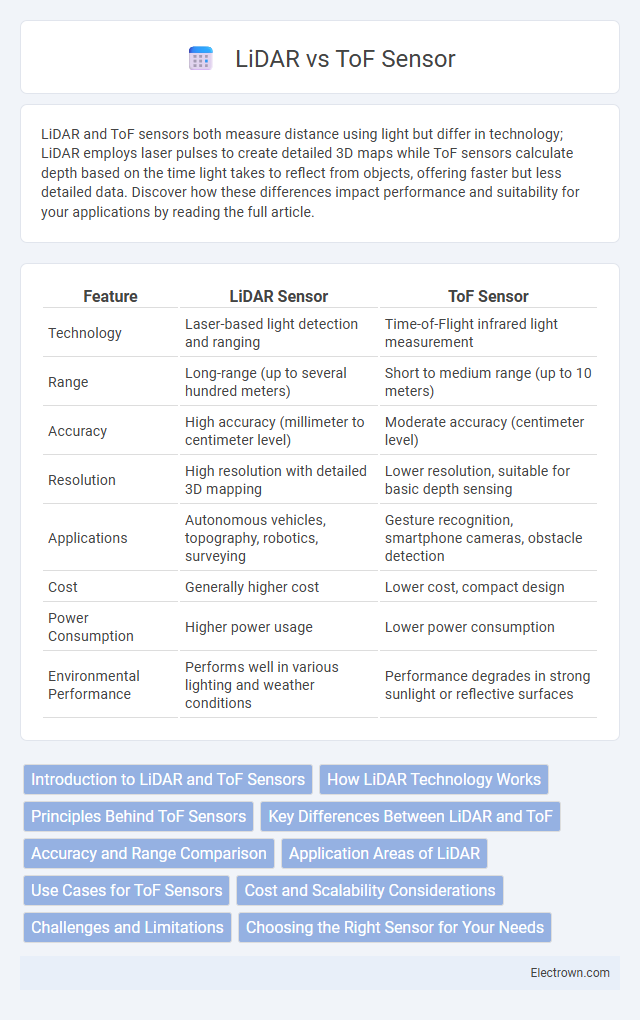LiDAR and ToF sensors both measure distance using light but differ in technology; LiDAR employs laser pulses to create detailed 3D maps while ToF sensors calculate depth based on the time light takes to reflect from objects, offering faster but less detailed data. Discover how these differences impact performance and suitability for your applications by reading the full article.
Table of Comparison
| Feature | LiDAR Sensor | ToF Sensor |
|---|---|---|
| Technology | Laser-based light detection and ranging | Time-of-Flight infrared light measurement |
| Range | Long-range (up to several hundred meters) | Short to medium range (up to 10 meters) |
| Accuracy | High accuracy (millimeter to centimeter level) | Moderate accuracy (centimeter level) |
| Resolution | High resolution with detailed 3D mapping | Lower resolution, suitable for basic depth sensing |
| Applications | Autonomous vehicles, topography, robotics, surveying | Gesture recognition, smartphone cameras, obstacle detection |
| Cost | Generally higher cost | Lower cost, compact design |
| Power Consumption | Higher power usage | Lower power consumption |
| Environmental Performance | Performs well in various lighting and weather conditions | Performance degrades in strong sunlight or reflective surfaces |
Introduction to LiDAR and ToF Sensors
LiDAR (Light Detection and Ranging) sensors use laser pulses to measure distances by calculating the time it takes for light to reflect back from objects, enabling high-precision 3D mapping and object detection. ToF (Time of Flight) sensors determine distance by measuring the time light takes to travel to and from a target, often using infrared signals for depth sensing in applications like gesture recognition and facial scanning. Both technologies are crucial in autonomous vehicles, robotics, and augmented reality, offering distinct advantages in accuracy, range, and environmental adaptability.
How LiDAR Technology Works
LiDAR technology operates by emitting laser pulses that bounce off surrounding objects and return to the sensor, enabling precise distance measurement through time-of-flight calculation. This scanning process generates high-resolution, three-dimensional maps of the environment with accurate depth information, essential for applications like autonomous vehicles and robotics. Unlike ToF sensors that typically use a single light pulse for depth sensing, LiDAR systems utilize multiple laser beams and rapid scanning to capture detailed spatial data over larger areas.
Principles Behind ToF Sensors
Time-of-Flight (ToF) sensors determine distance by measuring the time taken for emitted light pulses to reflect off objects and return to the sensor, utilizing the speed of light for accurate depth calculation. Infrared LEDs or laser diodes emit the light, while photodetectors capture the returning signal, enabling precise measurement of distance in real-time. This principle allows ToF sensors to generate detailed 3D maps with high temporal resolution, making them ideal for applications like gesture recognition, robotics, and autonomous navigation.
Key Differences Between LiDAR and ToF
LiDAR uses laser pulses to create high-resolution 3D maps with precise distance measurements, while ToF sensors measure the time it takes for light to reflect back, offering faster but less detailed depth data. LiDAR systems are ideal for long-range applications, providing accuracy up to several hundred meters, whereas ToF sensors work best at short to medium distances, typically under 10 meters. Your choice depends on the need for detailed spatial information versus speed and cost efficiency in depth sensing.
Accuracy and Range Comparison
LiDAR sensors typically offer higher accuracy and longer range capabilities, with precision measurements extending up to several hundred meters, making them ideal for detailed mapping and autonomous vehicle navigation. Time-of-Flight (ToF) sensors provide faster distance measurements but generally operate effectively within shorter ranges, usually up to 10 meters, which suits applications like gesture recognition and proximity sensing. The accuracy of LiDAR systems can reach millimeter resolution, while ToF sensors usually achieve centimeter-level precision, impacting their respective suitable use cases.
Application Areas of LiDAR
LiDAR technology is widely utilized in autonomous vehicles for precise 3D mapping and obstacle detection, enhancing navigation and safety. It is also essential in environmental monitoring, enabling detailed topographic mapping, forestry analysis, and disaster management. Urban planning and infrastructure inspection leverage LiDAR for accurate spatial data, supporting smart city development and maintenance.
Use Cases for ToF Sensors
ToF sensors excel in short-range distance measurement applications like gesture recognition, smartphone camera autofocus, and proximity sensing in robotics. Your devices benefit from ToF's fast response time and accurate depth mapping in indoor environments or constrained spaces. These sensors are ideal for enhancing user interaction and improving safety in automotive and consumer electronics.
Cost and Scalability Considerations
LiDAR sensors generally involve higher costs due to complex hardware components like lasers and rotating mirrors, making them less scalable for mass-market applications compared to Time-of-Flight (ToF) sensors. ToF sensors benefit from lower production costs by using simpler optical and electronic mechanisms, allowing for easier integration into consumer electronics and cost-effective scaling. The balance between precision and cost efficiency makes ToF sensors preferable in applications requiring large-scale deployment and budget constraints.
Challenges and Limitations
LiDAR sensors face challenges such as high cost, larger size, and sensitivity to environmental conditions like fog or heavy rain, which can degrade signal quality. Time-of-Flight (ToF) sensors struggle with limited range and accuracy in bright sunlight or reflective surfaces, impacting their performance in outdoor or complex scenes. Your choice between LiDAR and ToF should consider these limitations to ensure optimal application performance.
Choosing the Right Sensor for Your Needs
LiDAR sensors provide high-resolution 3D mapping and accurate distance measurement ideal for applications requiring precise spatial awareness, such as autonomous vehicles and topographic surveys. ToF sensors offer faster response and lower cost with sufficient accuracy for close-range object detection and gesture recognition, making them suitable for consumer electronics and robotics. Selecting the right sensor depends on factors like range, resolution, environmental conditions, and budget constraints.
LiDAR vs ToF sensor Infographic

 electrown.com
electrown.com